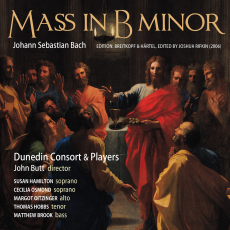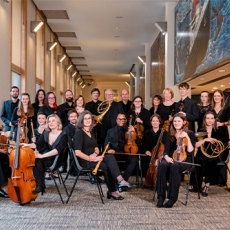Bach Mass in B Minor - Dunedin Consort - The Consort
The Dunedin Consort and Players' recording of Bach's Mass in B Minor is the first to be based upon Joshua Rifkin's 2006 edition of the work, published by Breitkopf & Hartel. This edition aims to reconstruct the Mass as Bach left it in 1750, stripping it of accretions from C P E Bach's later changes, and from those in the Dresden parts of 1733, to which Bach would not have had access to later. The chosen vocal scoring is predominantly for soloists, with doubling by ripienists only in selected choruses (for example, those with trumpets, or those in a stile antico setting with instrumental doubling of the vocal lines). The director, John Butt's rationale for the scoring is explained, along with an admirably clear summary of the whole ‘great Bach choir debate', in the extensive liner notes.The orchestra is also kept to a minimum, with doubling only in the violins.
For the most part, the stripped-down scoring works extremely well. The ensemble is very clean and every line is clear, and never stops dancing. In particular, I was impressed by the balance both in volume and colour between the oboes and the trumpets. At some points in the large choruses, however, the upper voices appear to be struggling to express the full grandeur of the setting. The quieter numbers have a new sense of intimacy and personal involvement. At times I was a little bothered by inconsistency in pronunciation (generally adhering to modern Italian convention), especially in terms of vowels.
In the arias and duets, the soloists have a great sense of partnership with the obbligato instruments, and many of this recording's most special moments occur in these more intimate numbers. Especially remarkable is alto Margot Oitzinger in the Qui sedes, where her straightforward, slightly reedy (in a good sense!) sound is a perfect match for the elegant oboe d'amore, and tenor Thomas Hobbs in the Benedictus, echoing the flute obbligato's beautiful sense of fantasy. The horn / bassoon obbligato of the Quoniam tu solus sanctus is astonishing: the instruments mesh so well that it is hard at times to tell who is playing.
The tempi are often on the fast side of the norm in modern performances. The Cum Sancto Spiritu is so fast that, despite heroically clean singing and virtuoso wind playing, I found it difficult to follow all the detail. The singers appear to be closely miked, and I wonder if a clean performance at this speed would really be feasible in a live context. The Sanctus, too, could probably achieve the same sweep of line with a slightly more settled tempo, to allow the full weight of the bass's sequence of descending octaves.
In other movements, however, the generally fast tempi are refreshing and particularly exciting (for example, in the Etresurrexit). The second Kyrie fuguereceives a sense of desperation that is often lacking in performances, underlined by the rhythmically urgent delivery of the off-beat entries. The Crucifixus works especially well at a faster tempo: the single short notes of the instruments, which might be read as representing thorns or nails, stand out sharply against the singers' mournful motifs, which become very personal through the solo scoring. The wayward modulation of the final passus etsepultus est, to which our ears might have become inured through frequent hearing, regains it's tremendous effect, further strengthened by a sense ofstress conveyed by the singers, in reaching for extremes of soft and low singing.
Altogether, this recording offers a fresh new hearing of this monument. Quibbles aside, the beauty alone of many of the solo numbers would make it worth buying.

